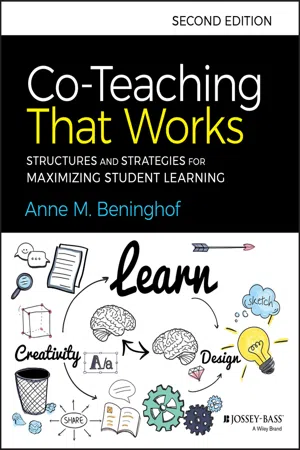
Co-Teaching That Works
Structures and Strategies for Maximizing Student Learning
Anne M. Beninghof
- English
- ePUB (apto para móviles)
- Disponible en iOS y Android
Co-Teaching That Works
Structures and Strategies for Maximizing Student Learning
Anne M. Beninghof
Información del libro
Guaranteed Success for the Co-teaching Classroom
Following the success of the first edition, Co-Teaching That Works: Structures and Strategies for Maximizing Student Learning, Second Edition is here to provide actionable advice to co-teachers seeking to utilize one another's strengths. Unlike other co-teaching books, this manual is written for every possible educator combination—not simply general educators. You'll find sections on everything from co-teaching in literacy and speech-language therapy to special education and technology so that, no matter what subject matter or expertise, you'll be prepared to co-teach.
This book is written to provide concrete, actionable advice, including:
- Co-Teaching Roll Out Plans
- Leadership Guidelines
- Relationship Development
- Best Co-Teaching Models
- Specially Designed Instruction
- And more
Educators will have the opportunity to learn from other experienced co-teachers who share their personal stories, tips, and tried-and-true co-teaching techniques that lead to student success. Their creative, time-efficientapproaches will revolutionize the way you view your classroom teaching strategies and enhance your ability to collaborate with other educators.
Whether you are planning to build your co-teaching strategy from scratch or just looking to refine your current approach, Co-Teaching That Works will undoubtedly be a priceless resource to have in your professional toolbox.
Preguntas frecuentes
Información
PART ONE
DEVELOPING A RECIPE FOR SUCCESS
CHAPTER 1
An Overview of Co-Teaching
What Is Co-Teaching?
What Does the Research Say?
- An elementary school study showed that students with disabilities made significantly more progress in co-taught classes than those in separate educational settings, with the difference growing over time (Tremblay 2013).
- A study on teacher competency showed that co-teaching resulted in improved content knowledge for special educators and improved pedagogical knowledge for general educators. Researchers concluded that co-teaching resulted in co-constructed professional development for participants which benefited students in inclusive settings (Shaffer and Thomas-Brown 2015).
- A research review concluded that when co-teachers work closely together and have the time to plan, small positive outcomes are achieved (Solis, Vaughn, Swanson, and McCulley 2012, 507). These same researchers found, comparing co-teaching to other forms of consultation, that “when specialists recommend improved instructional practices to teachers, instructional changes are unlikely to be realized in the classroom. However, when the specialists coordinate c...